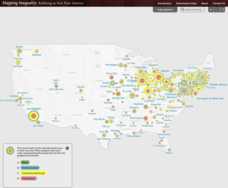Curated OER
The Brief American Pageant: The Great West and the Agriculture Revolution
What comes to mind when you think of the 1860's - other than the Civil War? Paired with The American Pageant textbook (or not), this series of images completes a lecture on the mid-19th century. Cattle trails, Indian wars, and...
Curated OER
Choices and Commitments: The Soldiers at Gettysburg
Students investigate the Gettysburg Campaign and the major actions for each day of the battle. They read primary source documents, write a diary entry, analyze the Gettysburg Address, and write a persuasive speech regarding an issue in...
University of California
Anti-Communism at Home
Have you ever been accused of something without cause? The sixth installment of an eight-part series asks scholars to create a museum exhibit on the anti-communist activities in the United States at the start of the Cold War. To make...
Digital Public Library of America
The Poetry of Emily Dickinson
Are you contemplating a poetry study featuring Emily Dickinson? Finding good primary sources to accompany the study can be a challenge—never fear, help is here! Check out this primary source set that includes manuscripts of several of...
Curated OER
America's Wars
Students classify information regarding American involvement in wars. In this classification lesson, students examine the causes of the war in which the United States has been involved, and classify them as mainly political, social,...
Curated OER
Emancipation Proclamation
Students analyze key components of a portrait and relate the elements to the historical context. In this lesson students evaluate the "Emancipation Proclamation" and it's significance.
National First Ladies' Library
Blunders on All Sides: The Battle of Bunker Hill
High schoolers investigate the concepts surrounding the historical battle of Bunker Hill while conducting online research using a variety of resources. The information is used in order to create a newspaper article telling about the...
Multieducator
Battle of Gettysburg
On July 1, 1863 the Army of Northern Virginia, under the command of General Robert E. Lee met the Army of the Potomac, under the leadership of Major General George Meade. Considered the turning point of the war, the Battle of Gettysburg...
Curated OER
Three Days at Gettysburg
Eighth graders discuss why the Battle of Gettysburg was important to the Civil War. In groups, they identify the major events of each day of the battle. They analyze how the battle changed the direction of the war and discuss the outcome.
Curated OER
Arkansas Black Pioneers: A History of African-American Colonies in Arkansas
Students research regions of early Arkansas as they relate to African American colonies in Arkansas after the Civil War. They discuss the characteristics of the regions, view a Powerpoint presentation, and write reflective journals.
Curated OER
Fort Pickens and Fort Barrancas Historic District
Students use maps, readings, photos and diagrams to identify and describe events in Pensacola, Florida that preceded the Civil War. They examine the role of Fort Pickens during the Civil War and consider the community impact of military...
Curated OER
The Battle of Pea Ridge
Young scholars examine the battle of Pea Ridge during the Civil War in Arkansas. They write a 3 point paragraph on the Battle of Pea Ridge between the Union and the Confederate troops.
Curated OER
Bentonville Battleground State Historic Site
Learners examine the Civil War battles of First Manassas in 1861 and Bentonville in 1865. They explore medical care in the field, how Union surgeons determined locations of field hospitals, and how battle affected nearby families
Curated OER
Sectionalism, Popular Sovereignty, and Secession
Young scholars examine sequence of national events that resulted in the Civil War by using primary sources, and creating timelines and maps.
Curated OER
"Mill Springs Battlefield"
Learners investigate the Civil War caused deep division in the border states and discover the significance of Kentucky to the Union and the Confederacy. They examine how battle casualties were and are honored in the local community.
Curated OER
Rivers Bridge State Historic Site
Learners use maps, readings, illustrations and photos to analyze the Civil War Rivers Bridge battlefield and describe how geography affected the outcome of the battle. They explore and explain the causes for the battle's heavy human...
Curated OER
Camp Chase Confederate Cemetery
Pupils use maps, readings and photographs to locate prisoner of war camps in the North during the Civil War. They identify the camp's population sizes and mortality rates and how the camps' uses have changed over time.
Curated OER
Brother Against Brother
Eighth graders read Across Five Aprils and correlate it to a unit on the Civil War. They culminate the unit by writing a a piece of historical fiction in the first person entitled "Brother Against Brother."
Curated OER
City Bound
Fifth graders identify the reasons for people migrating to cities after the Civil War. Using population data, they discover why populations in cities rose while rural populations fell during 1860 to 1900. They discuss the impact a...
Curated OER
Comparing Ethnic Groups
Eleventh graders explore the relationship between the United States and the Native Americans from after the Civil War to the early 1900's. They evaluate the actions of the United States towards Native Americans and compare the actions to...
Core Knowledge Foundation
Volume 1 - A History of the United States: Precolonial to the 1800s
Volume One of the 299-page Core Knowledge History of the United States covers events from the Precolonial Period to the 1800s.
New York State Education Department
US History and Government Examination: January 2011
The presidencies of John F. Kennedy, Richard Nixon, and Ronald Reagan were defined by the Cold War. Using primary source documents and scaffolded analysis questions, pupils explore the effect the Cold War had on these presidencies. A...
University of Richmond
Mapping Inequality: Redlining in New Deal America 1935-1940
Redlining—or the practice of racial discrimination in housing loans—directly led to today's segregated living patterns in America. Using data from the federal Home Owners' Loan Corporation, classmates visualize the impact of policy on...
NET Foundation for Television
1850-1874 African American Settlers
Go West, young man! Scholars investigate the impact of African American settlers moving to the Nebraska territory, following the passage of the Kansas-Nebraska Act in the mid 1800s. Using primary sources, timelines, maps, and...
Other popular searches
- American Civil War Maps
- Us Civil War Maps
- U.s. Civil War Maps
- Civil War Maps Printable
- Maps for Civil War























